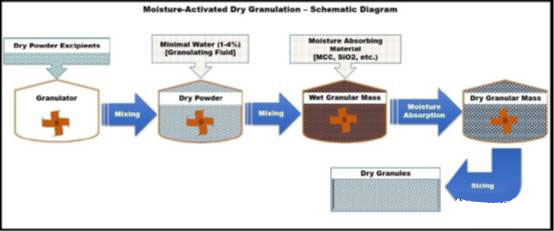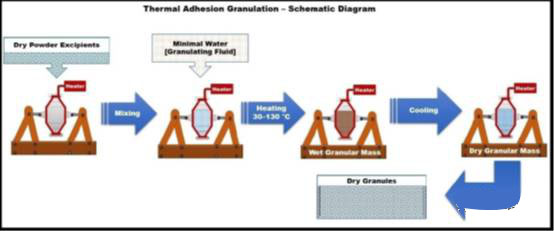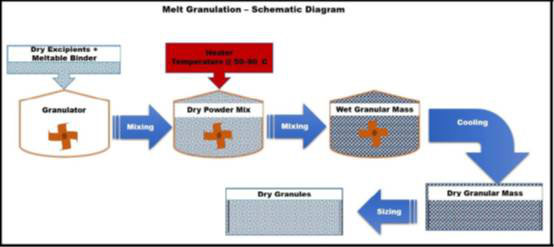Latest Granulation Techniques and Technologies III
Writer: admin Time:2021-01-25 17:23 Browse:℃
1. Moisture activation dry granulation (MADG)

MADG is a developing wet granulation technology. Little water is used to activate adhesive and block powder. Its process can be divided into two steps:
1) Powder moisturizing and agglomeration
2) Moisture absorption or distribution
By adding little water (normally 1-4%), the mixture of API, adhesive and other excipients can be agglomerated and granulated. Then hygroscopic materials such as MCC and silicon dioxide are added for redundant moisture absorption. The desiccants can absorb moisture from agglomerated mixture and distribute moisture in the material again. As a result, relatively dry granules are formed. During the process of moisture distribution, some granules’ size keeps constant, while some large agglomerates break and size distribution can be uniform. Drying is not needed in production of MADG.
Compared with regular wet granulation, MADG consumes less water. Therefore, there will be no large medicine blocks. The granule size will range from 150 to 500µm. The technology is also called dry granulation. But some confusion was thus caused on the terms. Someone thinks that in dry granulation powder is compressed or blown to blocks and then ground to granules. However, there is no such steps in MADG. And considering that water is used during MADG production, the term of dry granulation is not proper.
Therefore, moisturizing granulation can be better to refer to this technology. And the term of MADG is used by the inventor of this technology.
MADG can be applied in production of rapid-release preparation and control-release preparation and show some advantages: increasing granularity and improving granule fluidity and compressibility. Besides, the technology is also featured by wide application, high efficiency, low energy consumption, continuous production and simple operation steps. However, limited by the drug stability and operation problems, MADG cannot be applied to granulate drugs with high loading, drugs sensitive to moisture or hygroscopic drugs. Ideal MADG machine should be equipped with impeller, blade and cutter for ideal material status of motion and mixing. Therefore, the high shear mixing and granulating machine with a sprayer can be the proper equipment for MADG.
2. Thermal adhesion granulation (TAG)

A company from Taiwan developed thermal adhesion granulation, which is similar to wet granulation. It can agglomerate and granulate material with little granulating solution and heat. Different from MADG, TAG uses water and solvent as granulating solution. And material is heated to stimulate granulation.
Medical material and excipients are stored in an enclosed rotary system and heated to 30-130°C to be agglomerate. Only little granulating solution is added so that no drying step is needed. And granules with proper size can be made after cooling and sieving.
TAG is a comparably easy and convenient granulating means. The technology can be applied to produce granules with good compressibility or to better excipients’ properties by making use of little amount of moisture and adhesive. The produced granules have good roundness, fluidity and tensile strength. They can be pressed to tablets directly and these tablets have proper hardness and low brittleness. But some adhesives, as well as heat-sensitive material, cannot be processed in TAG.
3. Melting granulation

Melting powder is used as adhesive. The powder is melted, softened and agglomerated at pretty low temperature (about 50-90°C) during melting granulation. Granulation process is finished after agglomeration, cooling and solidification of powder and adhesive.
Adhesive with low melting point in the shape of solid granules can be fed into the granulator and then melts during granulation. Or the melting adhesive is sprayed onto the medical powder randomly. More particularly, the former way refers to that the medical powder, adhesive and other excipients are together heated up the melting point of the adhesive and the latter means that the melted adhesive is sprayed onto the heated powder and excipients randomly.
Melting granulation can process some medical powder which is sensitive to moisture. Besides, compared with traditional wet granulation, this technique obtains the following advantages: 1) No organic solvent or water solvent is needed. Therefore, there will be no other steps to use or recycle organic solvent. 2) Time and energy can be saved by skipping moisturizing and drying. Melting granulation can be applied to process moisture-sensitive medicines and to improve API’s stability. However, it is insufficient in that heating will degrade or oxidize the unstable API, especially the heat-sensitive medicine.
The adhesive for granulation can be either hydrophilic or hydrophobic. But this property can be the key influence on medicine dissolution. The equipment for melting granulation can be high shear mixing granulator and fluid-bed granulator. Recently, more attention has been drawn to melting granulation due to its above advantages.


